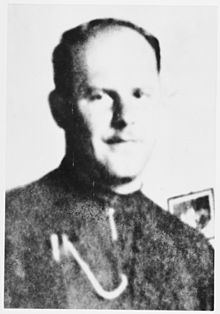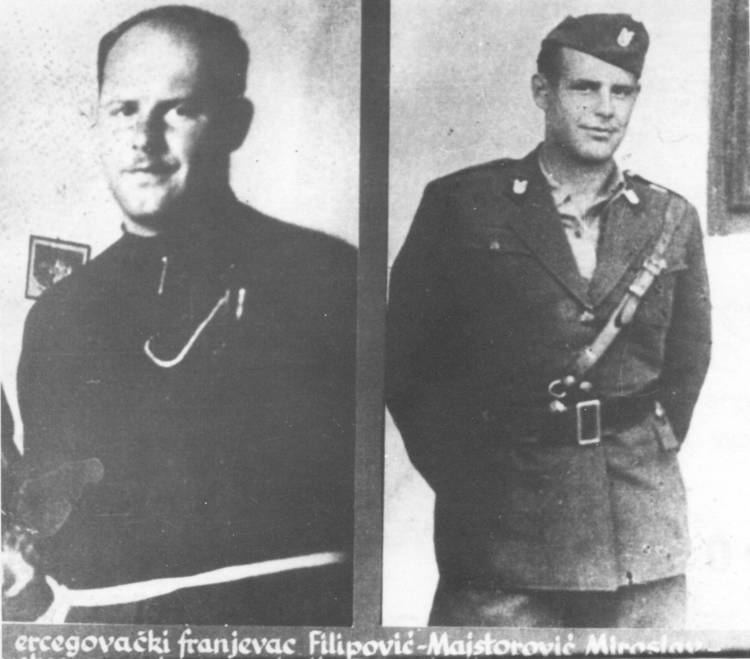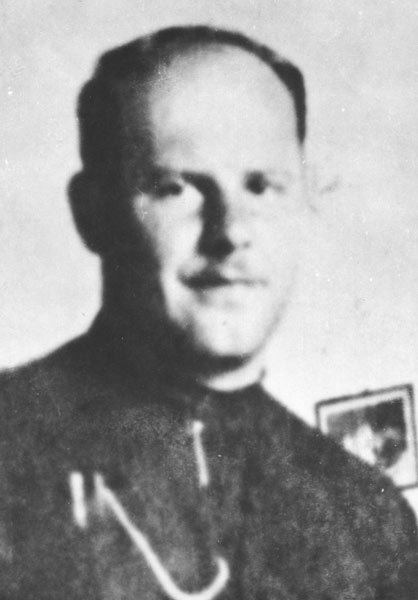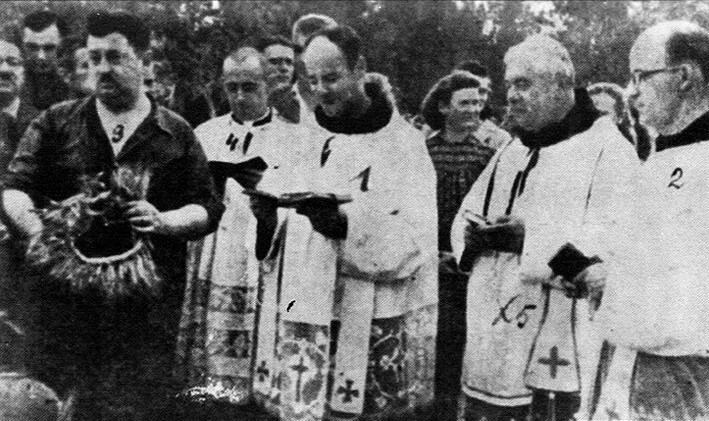Name Miroslav Filipovic | ||
 | ||
Born 5 June 1915 (age 30-31) Died 1946 (aged 30-31) Similar Ljubo Miloš, Petar Brzica, Dinko Šakić | ||
Miroslav Filipović (5 June 1915 – 1946), also known as Tomislav Filipović and Tomislav Filipović-Majstorović, was a Croatian Nazi collaborator, Franciscan friar and military chaplain. A convicted war criminal, he was executed in 1946.
Contents
- Znate li tko je bio fra Sotona
- Early life
- Ustaa chaplain
- Appointment
- Commandant of Jasenovac
- Commandant of Stara Gradika
- Post war
- References

During World War II in Yugoslavia, he participated in mass murder of Serbs, Jews and Roma, as well as Croat and Bosniak dissidents, by the Croatian Ustaše regime, particularly in the Jasenovac concentration camp. His savagery earned him the epithets "The Devil of Jasenovac" and "Brother Satan".

During the war, Filipović was convicted of war crimes by a German military court, but then released to officiate in a prison camp. In 1946, after the defeat of the Ustaše, a Yugoslav civil court executed him by hanging.

Znate li tko je bio fra Sotona?
Early life

Filipović's date of birth was 5 June 1915, but little else about his early years has been recorded. In 1938 he joined the Franciscan Order at Petrićevac monastery, Banja Luka, and took “Tomislav” as his religious name.

In 1941, following establishment of the Independent State of Croatia (NDH), a puppet state installed by the Axis Powers embracing Bosnia-Herzegovina as well as most of Croatia by the Ustaše, an organisation of extremist Croatian nationalists, Filipović was assigned to a chaplaincy in the Rama region in northern Herzegovina but did not take up the assignment. In January 1942, after completing his theological exams in Sarajevo, he became a military chaplain with the Ustaša. A report by the State Commission of Croatia for the Investigation of the Crimes of the Occupation Forces and their Collaborators (SCC), Section D-XXVI, entitled Crimes in the Jasenovac Camp (Zagreb 1946) is publicly available in English and Serbian.
Ustaša chaplain
Filipović (later known as Tomislav Filipović-Majstorović) was assigned to II Poglavnik Bodyguard Battalion. Statements by two eyewitnesses and a senior German general say that on 7 February 1942, Filipović accompanied elements of his battalion in an operation aimed at wiping out Serbs in the settlement of Drakulić, on the northern outskirts of Banja Luka, and in two neighbouring villages, Motike and Šargovac. A few Serbs survived, but overwhelmingly the operation achieved its objective; more than 2,300 Serb civilians – men, women and children – were killed, usually with axes or pick-axes.

Filipović was nicknamed by his troops "the glorious one", and he ordered that little Serbian children be brought before him, so that he could slaughter them, usually with knives. He and another priest, Father Zvonimir Brekalo, would kill these children by cutting their necks.
Reports sent to Eugen Dido Kvaternik, head of the state internal security service, from his Banja Luka office and dated 9 and 11 February 1942, noted that the Victims at Šargovac included 52 children killed at the village primary school. The first of these reports gives death tolls at the mine, the school and the three villages which together total 2,287. The second revises the death toll at the school from 37 to 52, bringing the toll to 2,302, 13 fewer than the immediately preceding estimate of 2,315.
Two schoolteachers survived the school massacre: Dobrila Martinović, who subsequently suffered a nervous breakdown, and Mara Šunjić, who gave evidence against Filipović at his postwar trial in Belgrade. According to Šunjić's trial testimony, Filipović not only participated in the atrocity but also incited fellow Ustaše to act with extreme cruelty.
By 1955, Martinović was teaching again, in Šiprage, southeast of Banja Luka. She described the Šargovac school massacre in conversations with a university professor, Jovo Jovanović, and with her headteacher, and her account was published in 1968. She explained that she had no reason to be alarmed when Filipović arrived at the school because he was based at the nearby Prebićevac monastery and was often seen passing through the villages. On previous occasions his manner had been friendly. The teacher recalled that when Filipović and some Ustaše entered her classroom, the children looked on with curiosity but no fear. Šunjić was ordered to separate the Orthodox children from the Catholic ones. Filipović took a child, Vasilija Glamočanin, and "slaughtered her with a knife" in front of the class. He urged the Ustaša troops who accompanied him to deal similarly with the other children and assured them that he would take the sin upon himself.
Viktor Novak had attributed a similar account to Martinović in Magnum crimen, with grotesque details: “As each child passed, an Ustaša would gouge out an eye and push it into the child's slit belly” etc. Similar atrocities occurred on 12 February 1942 at two more villages in the area, Piskavica and Ivanjska (now Potkozarje).
Filipović was court-martialed by the Germans for his involvement, possibly at the request of the Italian army which was then occupying part of the ISC territory. In his testimony to a Croatian state commission set up after World War II to investigate war crimes “by the occupation forces and their collaborators”, Filipović claimed he neither participated in, nor even attended, the 7 February massacres.
However, General Edmund Glaise-Horstenau, the senior German officer in the region, implicated Filipović in a report where he stated that as well as being present "during the slaughtering" the priest had attended a planning meeting prior to the massacres, along with certain other Catholic priests. He reported that the Ustaša's former city chief in Banja Luka, Viktor Gutić, and the city's court president, a Dr Stilinović, were also at the meeting.
On 4 April 1942, Filipović was reportedly suspended from his chaplaincy post by the papal legate in Zagreb and jailed in Croatia. There is no evidence that he was excommunicated by the Catholic Church, but he was reportedly removed from the Franciscan order on 22 October 1942, the date on which he was transferred to Stara Gradiška.
Appointment
Through the direct intervention of Vjekoslav "Maks" Luburić, who then headed Section III of the ISC internal security service (Ustaška Narodna Služba), which was responsible for administering the puppet state's system of prison camps, Filipović was quickly released and posted to the Jasenovac complex of labour and death camps where he was at first an inmate with benefited status, who aided the Ustase, and later appointed Ustase, commanding a small transit camp nigh Jasenovac, in early 1942, he reportedly killed an inmate there for hiding a loaf of bread.
Shortly thereafter he became chief-guard, responsible for mass-executions and lieutenant of the commander Ljubo Miloš and administrator Ivica Matković, and later, on 10 June 1942, administrator of the main camp in their stead, until the return of Matković, in March 1942. Luburić gave Filipović a new surname, "Majstorović", derived from a local word meaning "master" or "craftsman". From then on documents referred to him sometimes by that name and sometimes as Filipović-Majstorović. He won an apparent bet placed by him, Marinko Polić and Jerko Maričić, both infamous NCOs in the camp. Witness Josip Riboli stated:
Another particularly vicious killing was described by the former Jewish prisoner, Egon Berger, in his book, "44 months in Jasenovac":
Commandant of Jasenovac
After the war Filipović admitted that he had personally killed about 100 prisoners and had attended mass executions of many more. He estimated that under his command some 20-30,000 prisoners were liquidated at the main Jasenovac camp. He said prisoners would often be made to stand in prepared trenches where each was then killed with a sledgehammer blow. He went on to describe his tenure in command of Stara Gradiška, a prison camp primarily for women which was designated Camp V within the Jasenovac system:
After hearing from 62 Jasenovac survivors, whom it listed usually with complete addresses, the war-crimes commission in 1946 counted Filipović among 13 Ustaše who “stood out” for their brutality and direct involvement in the killing. It reported that even the cruelty of Ljubo Miloš, notorious for slashing prisoners to death in a mock clinic, was “surpassed in sadism” by Filipović. The commission saw Filipović's statement as a “crucial” acknowledgement of his participation in atrocities, but with respect to the numbers he had given, it noted: "All witnesses interviewed, who were prisoners themselves, speak with complete consistency and certainty of a far greater number, especially in regards to the number of victims killed by Majstorovic himself". The commission cited one witness, Tomo Krkac, who had described seeing Filipović “very often” shooting prisoners during so-called public executions and forcing prisoners to kill other prisoners with sledgehammers.
In one of the first published memoirs about life and death in the Jasenovac complex, a Croatian medical doctor and academic, Dr Nikola Nikolić, who had been imprisoned in Camp III, described his first meeting with Filipović: “His voice had an almost feminine quality which was at odds with his physical stature and coarse face”. Nikolić recalled standing in the second row of a group of prisoners who had been lined up to watch as another group of prisoners were herded in front of Filipović, who summoned Nikolić to the front so that, as a doctor, he could witness “our surgery being performed without anaesthetic”. Filipović then shot dead two prisoners and told a colleague to “finish off the rest”.
Nikolić quotes another survivor, Josip Riboli:
Riboli also gave evidence to the Croatian war-crimes commission. According to the accounts of some survivors, Filipović continued to act as a chaplain while commanding the camp and sometimes wore his Franciscan robes while carrying out his crimes. As a result, he came to be known as “Fra Sotona” (”Friar Satan”). According to Ronald Rychlak, Filopovic was "tried, laicized, and expelled from the Franciscan order before the war even ended", reportedly on 22 October 1942, the date on which he was transferred to Stara Gradiška.
In September 1944, Filipović, along with Dinko Šakić and others, was appointed to sit on an ad hoc court-martial convened to try prisoners accused of forging links with the partisans and plotting an escape. The Croatian War Crimes Commission in its report was at a loss to explain why such a process had been deemed necessary when Ustaše had already killed thousands of people “by heinous means, without any justification or procedure”. It reported that all 31 accused prisoners were hanged after undergoing severe torture including blindings, crushed fingers and blow-lamp burns. Filipović in his testimony said: “We [the court-martial] didn't investigate anything, we only signed the verdicts.” A witness, Dervis Sarać, recalled how three gypsies were brought to play music before Filipović, who, disappointed by the music, shot one and sent the others to their deaths. Another witness accuses him of having shot an inmate while eating lunch, after which deed he resumed eating.
Commandant of Stara Gradiška
As chief of camp Stara Gradiška, which predominantly housed women and children, Miroslav Filipović-Majstorović excelled in sadism. A Jewish survivor of Jasenovac, Egon Berger, described Filipović's sadistic killing of Serbian children, while, according to two other witnesses, Simo (or Sime) Klaić and Dragutin Škrgatić: Klaić recalls that in Christmas 1942, Miroslav [Filipović-Majstorović] ordered mass and later a muster, where he killed four inmates with a knife, while forcing a Jew of Sarajevo, Alkalaj, to sing, then ordering Alkalaj to near [approach] him, stabbing him in the chest and slashing his throat. Then he killed 56 Bosnian Jews by tying them with wire, hitting them with an axe so they all fell into a well. Then he shot around 40 Bosniak villagers in the head. Škrgatić confirmed that Filipović shot the villagers in the head after mass, adding:
"In Majstorović's time, musters and executions were frequent. Friar Majstorović favored a mystical approach to the killings.... After he killed them, sat on a chair and said 'justice has been done'".
Ivan Placec, a witness, added that Filipović shot nine inmates that day for an escape attempt. Josip Erlih also viewed a similar occasion, when, he claimed, eight inmates were shot by Filipović.
Post-war
In 1946 Filipović stood trial in Belgrade for war crimes. He gave evidence consistent with his statement to the Croatian war-crimes commission, admitting his participation in some crimes and denying involvement in others. He was found guilty, sentenced to death and hanged, wearing the robes of the Franciscan Order.
